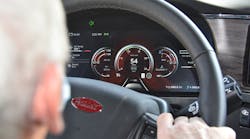Peterbilt made a mistake with the new Model 579.
As Jake White, Peterbilt product marketing manager, explained to me during our pre-release drive through the rolling prairie of North Texas in late January, the redesigned on-highway flagship was “basically done” a couple of years ago. But a presentation to key dealers and fleets sent the team back to the drawing board (or the digital-tool equivalent). Simply, that version of the truck “wasn’t a Peterbilt,” the advisory council advised.
“The easiest thing to do is to make a slippery truck and be done,” White said with a shrug. “So there’s a strong tension between the creative side—ensuring that it's the best-looking truck on the road—and the structural and performance side of it.”
By ‘slippery’ he means coming up with the mathematically perfect aerodynamic shape; by ‘easiest’ I assume he means it’s doable by a few global corporations with the expertise and wherewithal to devote teragobs of computer power to simulations and to translate the virtual vehicle analysis to tiny changes on clay models that ultimately are shaped in steel/aluminum/Metton.
So if that’s ‘easy,’ you have to hand it to the designers and engineers for taking on the really hard job of making the new Model 579, first and foremost, a Peterbilt. Now, I know a lot of people think that if it’s not a Pete 359/379/389 long-hood-and-chrome classic, it doesn’t count—but that just brings us back to my point about what a hard job the designers had. Let’s move on.
“When we launched [the original Model 579] back in 2012, using CFD was just getting started. The 579 is one of the trucks that really pushed our industry to sharpen the pencil—and our competitors have upped their game," White said. "But we still have some separation and we wanted more. That was the impetus behind this truck: separating ourselves, adding some technology and a bolder, stronger look.”
I got my first look at the new 579—painted with Peterbilt’s signature Legendary Red metal flake, of course—in the parking lot of the company’s Denton, Texas, manufacturing plant. (Belated happy 40th birthday, by the way, to the facility that has built more than 600,000 trucks since the first one rolled off the line in August 1980.)
The pre-trip walkaround took a little longer than usual as White enthusiastically detailed the redesign features great and small that make his “baby” special. (For the record, he has two young daughters—and if he’s as devoted to them as he is to the truck he’s spent the past five years of his life developing, then they’re lucky girls indeed).
For example, we spent a full five minutes discussing the virtues of the new optional LED headlamp with the three-function combo light in the bumper. To get a complete look at the design touches of the new fleet flagship, and to get the company’s superlative-laden description, check out the gallery here.
But as my mother always reminded me, it’s what’s on the inside that makes a person truly beautiful. Getting into the cab and behind the wheel of the new 579 is like finding out that your favorite Hollywood movie star is happy to help you move and will dog-sit while you’re away, and when you get home, you find the laundry clean, ironed and folded—even your socks.
In short, as White emphasized, while the computers were doing their fluid dynamics calculations, Peterbilt was talking to drivers about everything that’s important to them.
First and most obviously: Not every driver needs an UltraLoft, but everyone should have all that space anyway just because it will make you happy. I want to stretch out and take a nap just thinking about it. Or, for the more active, you could put in a home gym. But back to the little details of form and function that make the new 579 special.
Behind the wheel, the 15-in. Peterbilt Smart Display becomes the center of attention. Now, I love a handsome analog gauge cluster as much as anyone, but drivers half my age think of all those dials lined up across the dash as antiques, and maybe they're a little cool if you’re into steampunk.
So once you’re resigned to the fact that people born in the year 2000 can now get their CDLs, you’ll understand that multifunction digital screens are a must, and the bigger the better. But, White notes, the main gauges are reproduced in the familiar round shape.
“This is just a transition,” he said, the first of several such references to the truck's innovative features. “It’s all about building the driver’s trust in something that’s new and a little different.”
And if the truck can monitor it, the driver can pull it up on the configurable display. Indeed, the only issue I had with the system is that there’s a learning curve if you want to dig deep into the options—but I was only in the cab for two hours on a Wednesday morning, not on the road for two weeks at a time.
A couple of noteworthy items: If something’s not right—for example, the coolant is low—the system will alert the driver on startup, whether or not that gauge has been enabled in the normal display. Likewise, the display can perform a kind of pre-pretrip, running through a visual Systems Check that inspects 13 systems and provides a green checkmark with each passed test. Post-trip, a detailed Trip Information screen provides a breakdown of important metrics of the most recent run.
The driver-selectable features extend to the various advanced driver assistance system functions as well, such as an adjustable following distance in the smart cruise system. The optional Digital Vision System, to be available later this year, allows the driver to toggle through various views to display on the A-pillar mounted screens that, pending DOT approval, will eventually be a mirror alternative.
Of course, the point of the many, many features isn’t to take up pages in the driver’s manual; it’s to help the driver deliver the load. And on the road is where the new 579 really delivers.
We were hardly out of the parking lot before the ADAS proved its worth, reacting with some additional pedal pressure when a small sedan pulled out right in front of the GIANT RED TRUCK. The good news for truckers who have to put up with this all day, every day is that the new 579 will genuinely make your life so much more comfortable.
Once on the highway with smart cruise engaged, the truck does the work. So sit back and enjoy the improved view of the road ahead, thanks to the lower nose on the sloping hood. The lane keeping is flawless, with road-crown and crosswind correction inputs routed to the steering column’s electric motor. (Yes, the north wind does come sweeping down the plain from the other side of the Red River.) Once again, the steering feedback is adjustable to suit the driver’s preference for how loose or tight the wheel feels.
Falling in behind a couple of aggregate haulers, we convoyed for several miles at 70 mph with the cruise control handling the throttle. Moving into a hilly section, the new 579—loaded to 65,000 lbs. and powered by a Paccar MX mated to a Paccar 12-speed automated transmission—effortlessly maintained speed, and we left the dump trailers behind.
And in those rolling hills is where the predictive cruise technology proves its value. Drawing on its routing database and GPS positioning, the truck applies pedal ahead of inclines and coasts over crests. White credits the technology with 1% of the 7% fuel efficiency improvement the new 579 brings (the aero design accounts for 4% and the integrated powertrain 2%).
Pulling off the highway for a lunch stop, the ADAS again steps in and steps a little harder on the brake when we approach the exit and sharp turn a little fast. And as we back into a parking space at the truck stop, I find I've already come to rely on the pillar mounted display rather than the mirrors for a view of the trailer.
Over burgers, White quizzes me on the drive so far—and I find myself with very little to say. Basically, I didn’t have anything to report because everything worked. The ride was little different than my drive to Dallas in an SUV. My anxiety about this only got worse on the return leg. The more I tried to provide some feedback, the more overwhelmed I became by how smooth, quiet and comfortable is the new 579.
Or, in White’s engineer-speak: That noise I didn’t hear is the result of new engine mounts acoustically tuned to isolate vibration. Not that there's a lot of vibration cruising at 1,050 rpm.
Back at the plant, White noticed that one of the tandem-axle fairings was askew, likely the result of a clipped curb. He used his foot to shove it back in place, as designed.
“Our industry is tough on trucks and hard on equipment," he said. "That's one of the things that's exciting about it: We can always make [our trucks] better. We thrive in that.”





